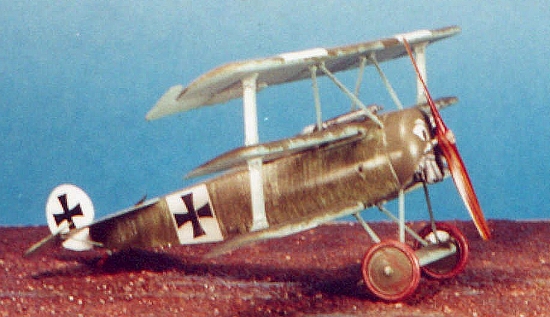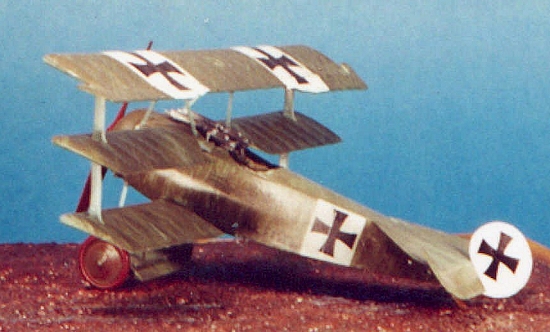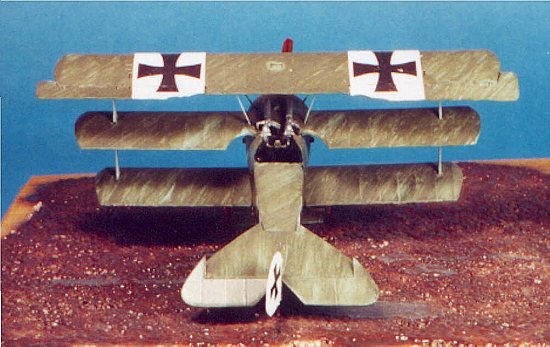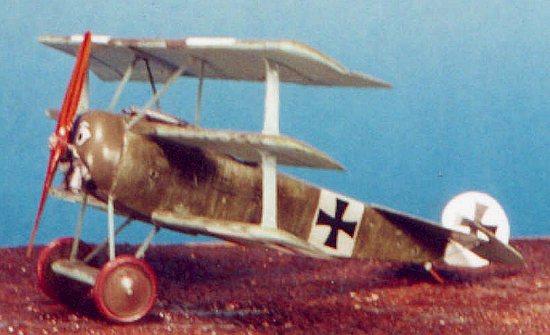
|
KIT # |
5901 |
|
PRICE: |
$19.95 |
|
DECALS: |
See Review |
|
REVIEW & |
|
|
NOTES: |
Made with
Rosemont Hobbies Roseparts Fokker F.1 Conversion |

|
HISTORY |
The Legendary Werner Voss:
Of the German aces the fighter pilots of the Royal Flying Corps faced on the Western Front, few were more respected than Leutnant Werner Voss, who began his career as a fighter pilot in November 1916 with the legendary Jasta 2 "Boelcke," and ended it ten months later as Commanding Officer of Jasta 10, a winner of the "Pour le Merite" - also known as "The Blue Max" - and 48 victories, all scored on the Somme Front. His career was the stuff of legend, the veritable model for the World War I flying ace of the pulp novels a new generation of fighter pilots would read as youths in the 1920s and 1930s.
As if his career was not enough, his death was even more legendary. On September 23, 1917, having just scored his 48th victory on a previous patrol, he set out at dusk with the goal of gaining two more victories to bring his score to an even 50. North of Frezenberg, Voss dove his Fokker F.1 triplane on an S.E.5a. At that moment, RFC ace Capt. James B. McCudden - commander of 56 Squadron - spotted the the triplane diving on the S.E. 5a and turned with his wingman, Lieutenant Albert Rhys-Davids, to give help as the other four 56 Squadron aircraft turned to follow. Voss turned from his intended victim and gave battle to the group of 56 Squadron aces. After a few minutes, he was joined by a red-nosed Albatros D.V, which tried to cover him. During the next ten minutes, Voss outflew his seven opponents, shooting down two and damaging the other five as the British pilots felt they were fighting for their lives. Finally, after reloading his Lewis gun for the third time, Rhys-Davids managed to hold the triplane in his sights long enough to fire off a fourth 97-round drum and almost all the ammo for his Vickers. Rhys-Davids reported, "He made an attempt to turn and we were so close I was certain that we would collide. He passed my starboard wing by inches and went down. I saw him next with his engine apparently out, gliding east. I dove, and got one final burst. I overshot him, zoomed, but never saw him again." McCudden reported, "I saw him go into a fairly steep dive and so I continued to watch, and then saw the triplane hit the ground and disappear into a thousand fragments, for it seemed to me that it literally went into powder. His flying was wonderful, his courage magnificent, and in my opinion he is the bravest German airman whom it has been my privilege to see fight." Rhys-Davids held his opponent in such respect that he said upon learning it was Voss, "If I could only have brought him down alive."
The Fokker F.1s:
 By 1917, Tony Fokker was looking for a way back into the game, since his
D.II-D.V series of fighting biplanes had been deemed unacceptable for
operational use due to shoddy construction at the factory, and been relegated to
second-line and training duties.
By 1917, Tony Fokker was looking for a way back into the game, since his
D.II-D.V series of fighting biplanes had been deemed unacceptable for
operational use due to shoddy construction at the factory, and been relegated to
second-line and training duties.
That Spring, the appearance of the Sopwith Triplane would have an effect on Idflieg, the German air command, similar to that of the Nieuport sesquiplane the year before - in which every German fighter became a sesquiplane whether they should have been or not, in an attempt to match the Nieuport's performance. The same would happen with the Sopwith Triplane, and result in the appearance that summer of the Fokker Triplane, which is arguably one of the most famous fighters of the First World War, even if it was not really that good an airplane. Even the legendary triplane maneuverability of the Fokker was not as good as that of the Sopwith product, due to the fact the Fokker only had ailerons on the upper wing, rather than all three wings like the Sopwith.
In July, 1917, Fokker built three pre-production triplanes, designated the F.1 (the production triplane would be known as the Dr.I.) The F.1 differed in several details from the later production-standard Dr.I, most noticeably the fact that the leading edge of the horizonal stabilizer was curved, rather than straight, and the ailerons had slightly less area in planform. Also, the cowling had a higher "lip" than the later cowlings.
Two F.1s were presented to Jasta 2; F.1/102 was used by Manfred von Richtofen only a few times before he was wounded in combat in August 1917, and one was provided to Werner Voss, who put his to very good use indeed. In the first 10 days of August, he scored five victories, with four more by the end of the month. By September 10, he had scored 5 more in two combats. He had been sent home for a rest which turned out to be one of Tony Fokker's continuous parties in Berlin, this one to celebrate Bruno Loerzer's "Blue Max". He returned September 23, which would be the day of his final death.
|
THE KIT |
 DML/Dragon's Fokker Dr.I has been considered one of the best First World War
models since its release nearly 10 years ago. Other than a need to sand off the
sagging-fabric effect on the lower surfaces, the kit makes up into an accurate
model of the Dr.I; it is a good kit for someone to get hold of to enter the
field of World War I modeling, as the airplane does not have the mass of rigging
found on other aircraft of the period.
DML/Dragon's Fokker Dr.I has been considered one of the best First World War
models since its release nearly 10 years ago. Other than a need to sand off the
sagging-fabric effect on the lower surfaces, the kit makes up into an accurate
model of the Dr.I; it is a good kit for someone to get hold of to enter the
field of World War I modeling, as the airplane does not have the mass of rigging
found on other aircraft of the period.
This past fall, Roseplane Hobbies released a resin update set for the DML kit that would allow a modeler to build an accurate Fokker F.1, with a correctly-shaped resin horizontal stabilizer, ailerons, and cowling. The set also included decals for F.1/101/17. F.1/102/17 and F.1/103/17, the three aircraft that reached the front. F.1/103, the airplane flown by Voss, also included the decals for the eyebrows and moustache painted on the cowl of his airplane.
(It should be noted that Roseplane has also released a correction set for the Eduard 1/72 F.1, with a corrected upper wing, horizontal stabilizer and cowling.)
|
CONSTRUCTION |
I cut off the ailerons from the upper wing, and positioned the resin ailerons in a dynamic pose. I also cut off the elevators from the horizontal stabilizer then glued them back on in a drooped position. I then went on and constructed the fuselage per the instructions. I refer you to Bob Laskodi's excellent review here about building the DML Triplane. Once the fuselage was assembled, it was time to paint the separate parts with the "streaky" Fokker factory camouflage.
|
PAINT & DECALS |
The Fokker F.1s differed from the Dr.I in that the entire airframe was painted the "turquoise blue" that was painted only on the lower surfaces of the production Dr.Is, which were left in clear-doped linen on their upper surfaces. I used Gunze-Sanyo RLM65, a World War II color that many WW1 modelers think might have been carried over from the first conflict, since it is a very "turqoise" color. When this was dry, I covered the surface with Testors Glosscote lacquer varnish. I wanted a non-acrylic paint between the two colors, so I would be able to create the "streaky" effect without harming the color below.
Doing the "Streaky Camouflage":
 I used Gunze-Sanyo RLM71 "Dunkelgun" for the "Olive
Green" color, on the same basis as why I chose the RLM65 blue. I used a
1/4" wide flat-tip brush to apply the paint. As I put it on a section of
wing, I would then dip the brush in rubbing alcohol to clean it, then paint
rubbing alcohol over the paint to "streak" it. Once I had the effect I
wanted, I moved on to the next section, then on to the fuselage and horizontal
stabilizer in turn. The reason for painting the model at this stage is that the
wings have the camouflage streaks in a 45-degree angle, while the fuselage has
it straight up and down on the sides and at an angle on top, while the
horizontal stabilizer has the streaking fore and aft; doing these parts while
they are separate is much easier. The "wing axle" of the Triplane was
the gas tank; as it was metal - as was the center section of the middle wing -
these were painted solid olive green.
I used Gunze-Sanyo RLM71 "Dunkelgun" for the "Olive
Green" color, on the same basis as why I chose the RLM65 blue. I used a
1/4" wide flat-tip brush to apply the paint. As I put it on a section of
wing, I would then dip the brush in rubbing alcohol to clean it, then paint
rubbing alcohol over the paint to "streak" it. Once I had the effect I
wanted, I moved on to the next section, then on to the fuselage and horizontal
stabilizer in turn. The reason for painting the model at this stage is that the
wings have the camouflage streaks in a 45-degree angle, while the fuselage has
it straight up and down on the sides and at an angle on top, while the
horizontal stabilizer has the streaking fore and aft; doing these parts while
they are separate is much easier. The "wing axle" of the Triplane was
the gas tank; as it was metal - as was the center section of the middle wing -
these were painted solid olive green.
What Color Was Voss' Airplane?
Ever since he was shot down, there has been controversy over the exact colors of Voss' airplane. There is no easier way to start a controversy among WW1 modelers than to declare "Voss' cowl was yellow," or that "it was olive green!" It is like throwing a rock amongst a flock of chickens. This controversy is also stoked by a now-nonexistant Fokker triplane cowl that used to be at the Imperial War Museum, that was overpainted yellow, and was claimed to be from Voss' airplane. I come down on the olive green side. This is the color the airplane was painted when it came out of the factory, and I don't think Voss would have taken the time to have the cowl painted and the airplane unserviceable, while he was out hunting every day that the weather allowed in August and September.
I also rely on the testimony of Herr Timm, who was mechanic to Voss and later to Udet, as recorded in an interview in "Cross and Cockade" in 1961 shortly before his death. Timm said the airplane was "earth grey and blue," with no yellow. "Hold on!" I hear you saying, "What's this 'earth grey" business? I thought you said it was olive green?"
Here's the answer:
 The pilots of 56 Squadron reported the airplane was silver and blue. Remember
they were seeing it in the last light of day, with the sun low on the horizon.
Timm says it was "earth grey." It's just been painted overall
Turquoise Blue with a streaky pattern of Olive Green over the upper surfaces.
The fact the airplane is overall turquoise blue - rather than clear doped linen
color on the upper surfaces like the production triplanes - is the controlling
factor of this optical illusion.
The pilots of 56 Squadron reported the airplane was silver and blue. Remember
they were seeing it in the last light of day, with the sun low on the horizon.
Timm says it was "earth grey." It's just been painted overall
Turquoise Blue with a streaky pattern of Olive Green over the upper surfaces.
The fact the airplane is overall turquoise blue - rather than clear doped linen
color on the upper surfaces like the production triplanes - is the controlling
factor of this optical illusion.
Look at the photos of the completed model. The jpgs are color-corrected, and - assuming your computer screen is color-correct - you are looking at a model painted as I described. But look again: it appears greenish-grey (almost like RLM02) on the upper surfaces with the streaky camouflage paint, due to the fact you can see the blue through the green; your eye is "color correcting" what you see to what seems to be a color like RLM02, which is very close to a color the Russians called "earth grey" during the Second World War. Look carefully and the "solid" areas, the cowling, center wing center section and wing-axle, are obviously Olive Green. If you hold a light on the model, as it would be while catching the sun as it twisted and turned in a dogfight, the "green-grey" does take on a silver hue for some moments, thus the report of "silver and blue."
I think Herr Timm explained things as best he could, being a mechanic and not a painter. Given the light conditions under which they fought, I think the 56 Squadron pilots did, too.
|
CONSTRUCTION CONTINUES |
Having applied the decals, using national markings from an Aeromaster sheet that was superior to the decals that came with the kit, the model was ready for assembly per the kit instructions, and went together with little difficulty.
|
CONCLUSIONS |
I've done several of these triplanes and will likely do more in the future. It's a good kit, there are lots of interesting markings for planes flown by famous aces, and they all look great sitting amongst the rest of my World War I collection. Doing this one was the most fun though, because I think I was able to "prove" my side of an 84-year old argument (though I doubt it will change the religion of the "yellow cowl bunch" regardless).
Roseplanes F.1 Correction Set supplied by and made by Rosemont Hobbies. Thanks for your support.
If you would like your product reviewed fairly and quickly, please contact the editor or see other details in the Note to Contributors.